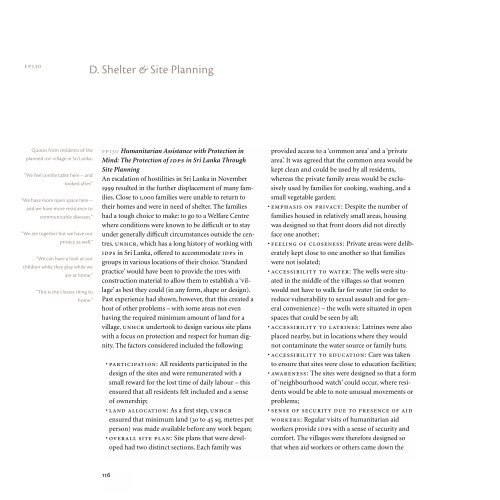Growing the Sheltering Tree Growing the Sheltering Tree
Growing the Sheltering Tree Growing the Sheltering Tree
Growing the Sheltering Tree Growing the Sheltering Tree
You also want an ePaper? Increase the reach of your titles
YUMPU automatically turns print PDFs into web optimized ePapers that Google loves.
FP130D. Shelter & Site PlanningQuotes from residents of <strong>the</strong>planned IDP village in Sri Lanka:“We feel comfortable here – andlooked after.”“We have more open space here –and we have more resistance tocommunicable diseases.”“We are toge<strong>the</strong>r but we have ourprivacy as well.”“We can have a look at ourchildren while <strong>the</strong>y play while weare at home.”“This is <strong>the</strong> closest thing tohome.”FP130 Humanitarian Assistance with Protection inMind: The Protection of IDPS in Sri Lanka ThroughSite PlanningAn escalation of hostilities in Sri Lanka in November1999 resulted in <strong>the</strong> fur<strong>the</strong>r displacement of many families.Close to 1,000 families were unable to return to<strong>the</strong>ir homes and were in need of shelter. The familieshad a tough choice to make: to go to a Welfare Centrewhere conditions were known to be difficult or to stayunder generally difficult circumstances outside <strong>the</strong> centres.UNHCR,which has a long history of working withIDPs in Sri Lanka, offered to accommodate IDPsingroups in various locations of <strong>the</strong>ir choice. ‘Standardpractice’ would have been to provide <strong>the</strong> IDPs withconstruction material to allow <strong>the</strong>m to establish a ‘village’as best <strong>the</strong>y could (in any form, shape or design).Past experience had shown, however, that this created ahost of o<strong>the</strong>r problems – with some areas not evenhaving <strong>the</strong> required minimum amount of land for avillage. UNHCR undertook to design various site planswith a focus on protection and respect for human dignity.The factors considered included <strong>the</strong> following:• PARTICIPATION: All residents participated in <strong>the</strong>design of <strong>the</strong> sites and were remunerated with asmall reward for <strong>the</strong> lost time of daily labour – thisensured that all residents felt included and a senseof ownership;• LAND ALLOCATION: As a first step, UNHCRensured that minimum land (30 to 45 sq. metres perperson) was made available before any work began;• OVERALL SITE PLAN: Site plans that were developedhad two distinct sections. Each family wasprovided access to a ‘common area’ and a ‘privatearea’. It was agreed that <strong>the</strong> common area would bekept clean and could be used by all residents,whereas <strong>the</strong> private family areas would be exclusivelyused by families for cooking, washing, and asmall vegetable garden;• EMPHASIS ON PRIVACY: Despite <strong>the</strong> number offamilies housed in relatively small areas, housingwas designed so that front doors did not directlyface one ano<strong>the</strong>r;• FEELING OF CLOSENESS: Private areas were deliberatelykept close to one ano<strong>the</strong>r so that familieswere not isolated;• ACCESSIBILITY TO WATER: The wells were situatedin <strong>the</strong> middle of <strong>the</strong> villages so that womenwould not have to walk far for water (in order toreduce vulnerability to sexual assault and for generalconvenience) – <strong>the</strong> wells were situated in openspaces that could be seen by all;• ACCESSIBILITY TO LATRINES: Latrines were alsoplaced nearby, but in locations where <strong>the</strong>y wouldnot contaminate <strong>the</strong> water source or family huts;• ACCESSIBILITY TO EDUCATION: Care was takento ensure that sites were close to education facilities;• AWARENESS: The sites were designed so that a formof ‘neighbourhood watch’ could occur, where residentswould be able to note unusual movements orproblems;• SENSE OF SECURITY DUE TO PRESENCE OF AIDWORKERS: Regular visits of humanitarian aidworkers provide IDPs with a sense of security andcomfort. The villages were <strong>the</strong>refore designed sothat when aid workers or o<strong>the</strong>rs came down <strong>the</strong>116
















